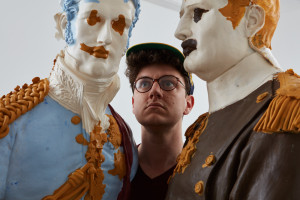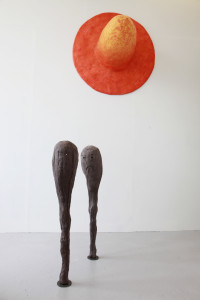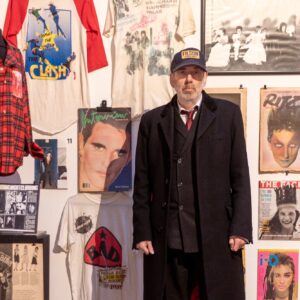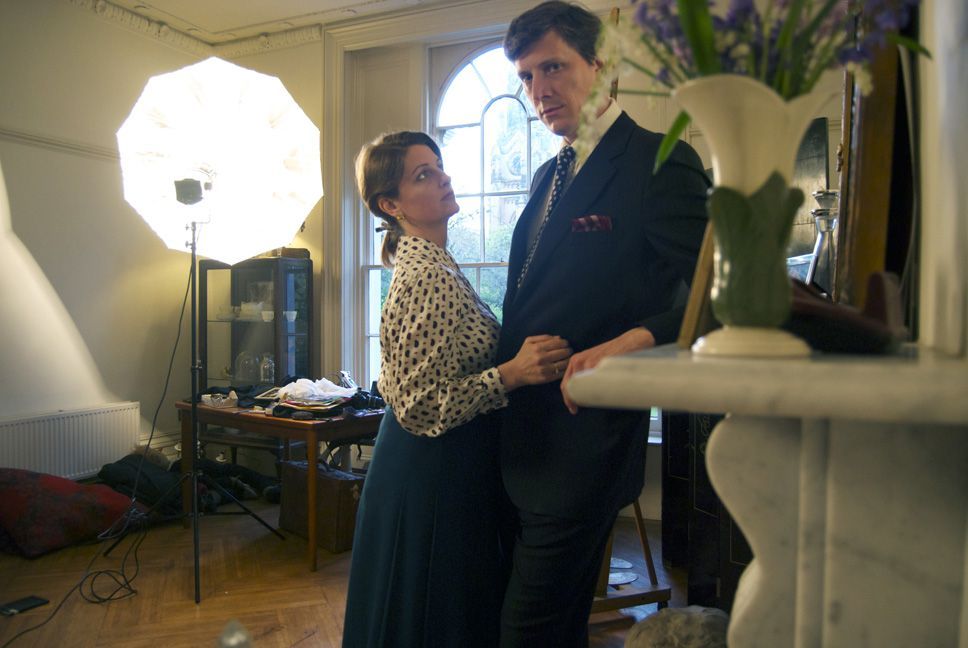
Mr. & Mrs. Philip Cath in their studio London
Over the next few weeks FAD will be featuring interviews and Q & A’s with the shortlisted artists from the prestigious Catlin Art Prize 2014 up forth is Mr & Mrs Philip Cath from Goldsmiths interviewed by Harriet Thorpe.
I met Catlin Art Prize nominees Mr & Mrs Philip Cath in their studio to discuss their work and ideas about art. The Cath’s studio is located in the idyllic domestic bliss of Blackheath. In the room, a panelled window frames a church spire and looks out onto a green lawn. A huge painted canvas on one side of the room mirrors a still life, which is set up on the opposite side of the room.
PC: We always joke that we live in Cathedral Close, the Constable painting of Salisbury Cathedral.
KC: You get quite a lot of psychological isolation. It’s almost like a magical land, you’re in London but not really in London. It’s old fashioned out here and it’s important to not be so far in the forest that you cant see anything, its good to be able to dip in and out.
PC: I think that the world and society is changing more quickly now. For a long time it was very stable and in the last 15 years – its incredible the rate of change in every regard, the way everyone’s living their lives. That actually makes it a good time to be an artist, its all part of processing those changes.
HT: Can you describe your artwork?
KC: Have you been reading about Post Internet art? Post Humanism? Its to do with the online network, how culture spreads like wildfire and about super hybridity. Post Humanism is about the way life changes. Cyber bullying, for example, we didn’t have to deal with 20 years ago. We are the generation negotiating the relationship technology is having on our lives. Human capital is now measured in units of millions, billions of YouTube hits, massive mathematical numbers. With our paintings, we use balloons as metaphors of human units.
Instead of being about specific works, art criticism is now involved with culture and society and that starts an interesting discussion. Writers, thinkers and artists are reacting on that. In art history there’s always that crest of the wave, essentially where some artists who are not scared to be alienated, traditionally artists that work on that are self-alienating. We’re also not interested in the aesthetics of contemporary art. We’re more centred in skills. When you’re critiquing and thinking about culture, you always have to be willing to be alienated.
PC: Antony Gormley told us, you have to stand on the cliff edge long enough that you actually get used to being there, I think about that all the time. It’s very precarious.
KC: It takes nerves of steel. You have to get used to being in a life where you can’t desire, it’s very Buddhist, you can’t want things, you wait. It ends up having its own curious benefit, the longer you want something, the more profound the desire and the more it means when you actually get it.
PC: We’re quite into self-denial in an odd sort of way. We have a puritanical palette and a starkness of the moral subject matter so it works on a sort of traditional northern European protestant art and we find it liberating.
KC: Art is always this forward current, this motion, and once in a while you have to fight and dig out against it. In art, its been really fashionable for a long time to have no rules. Art around the First World War was really strong because people really felt the amount of death that was going around, there was so much material to respond to. Now it’s kind of meta-urban, not quite sub-urban, where the platitude of life is so benign; shopping, walking – there’s nothing that provokes profoundness and that response to pain.
Because we have a lot of structure and rules, its harder to make paintings. It’s more difficult to make everything from scratch than it is to invent things from the top of your head. This painting, we had a feast of people sitting around the table and there was a glass which looks like it’s suspended in mid air, but it was on a carafe with black cloth over it – so it looks like magic, but its not, it’s really tediously created. And the reason why we work from life, you always have a multiple view. These paintings would look so different if they were done from a photo. And its more difficult to do that but for some reason, the impossibility and the difficulty… its the labour, the balloons also, are so difficult to work with. They cloud over, they change.
PC: They start crystal clear, then cloud over after three days.
KC: It’s really beautiful. We have all sorts of silicon sprays, we try to bring them back. We only occasionally replace them. The other frustrating thing is that they have no life in them, they’re really horrible objects. It takes careful modelling to give them pathos, so that they feel sad, beautiful and longing. And often it’s so subtle, it’s like they taunt us.
PC: It’s a really fraught experience – sometimes they suddenly pop which is terrifying when you’re working really hard.
HT: It’s really funny, because they’re supposedly still objects, but they have a life of they’re own.
PC: That’s why they’re such a good metaphor.
KC: It’s been quite unfashionable to use portraiture and still life in contemporary art, nobody touches it.
PC: The balloon is an effigy, which makes dealing with the figure bearable. You can at one time be more brutal and also more sympathetic.
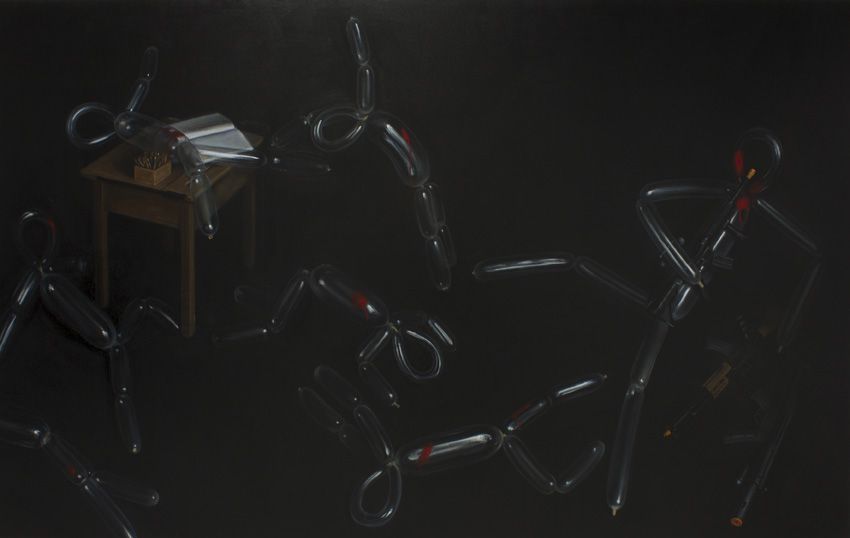
Mr. & Mrs. Philip Cath, Massacre of the Innocents, 2013, Oil on Linen
HT: How did you find this balloon motif?
PC: We wanted to say something about modern society and humankind without all of the problems you have with figure painting. We were thinking of stick figures and questioned how they could become interesting.
KC: Firstly we were thinking of foam, then we started sketching stick figures as a subject, distilling down just the idea and nothing else. It’s useful to be able to use humans to talk about things.
PC: We also wanted to have a sculptural presence. The way that we work is essentially more sculptural and the difficulty with a stick figure is that it casts no shadow, it holds no light. We were thinking of ways of welding aluminium stick figures, then there was just a flash of inspiration. The thing with every material is that it holds its own whole universe of research, materiality and specificity. Everything has its own politics and resonances. So we dived into the world of balloons.
HT: You said your work focuses on metaphor before the aesthetic form, but you have thought so much and worked on the appearance of how these balloons look?
PC: That works well in the metaphor as well. It’s the allure of the surface, like Glamorama by Bret Easton Ellis is very much about the surface of things and the beauty which helps to create this kind of disturbance. In our pantings there’s a tension between whats appalling and what’s incredible because its a discussion as well.
HT: Can you tell me how you construct your compositions and about your painting practice?
KC: We always work with black, I think black is our super collider, its really pure, its universal. We think about our paintings in terms of history paintings. So the classroom massacre painting, we used our childs desk in it – we argued for about a week if we should do this painting. It felt really horrible because its really real, children really did die in Sandy Hook, it was quite a heavy subject. Its an enormous painting as well, so theres a real societal implication.
PC: It’s a modern history painting. We’re fascinated by David and the history painting of the Napoleonic era.
KC: It’s painted in a traditional way and it’s quite a modern position to ask, how does painting feel about art? We are throwing a grappling hook back to contemporary art and saying, what happens if we accept all these things?
PC: That’s what I like about paintings essentially, all good paintings invite readership and I know that some people cant stand that, but to me it’s a real pleasure.
KC: Painting is a constant crisis and trauma, I don’t know how to describe this… I don’t know if you’ve ever had a boyfriend where there’s a bit of friction there – it’s like that with the paintings, there’s an incredible frustration. With this painting in particular (she points towards the large canvas in the studio) we’ve had nightmares building up the background, we’ve had the struggle, we will always feel the crisis of painting, there’s some kind of real tussle. You kind of fantasize about how is could be so easy…
PC: I think a painting should be interesting in every way. It should be interesting in how its made, the dynamics of how its made, where its made, what its about, how it looks, what it might be talking about and its a really hard thing to do and I think most paintings made today are interesting in one or two ways, but the challenge we set ourselves is it should be interesting in everyway, its obviously impossible thing to do, but thats what we set ourselves.
HT: So this is the piece you’re working on for the Catlin Prize? Can you tell me more about it?
KC: We have this theme of feminism, the bits of feminism that are degraded through translation essentially, so for instance, sexual liberalisation, is empowerment, therefore to be empowered you should be sexy. Its about the slippery bit between the utopian ideal and the decaying principle and the way that feels in modern life. With this one, there’s a certain voyeurism and everyday sexism is an example of this. Its all about self-reflection. Theres this obsession we have, every single day in the newspaper there is something about feminism, so we were trying to aestheticise the collision of reality vs. the utopian feminist. The bunny being the metaphor for fertility and breeding and the violent act of domestic life as it happens and the splattering brains! We’ve been using pink as a metaphor for the aesthetic of the utopian, the princess, that colour hue which defines “girliness”. You could write a phd on just that colour and its relationship. Its a perfect colour to use to activate and talk about feminism.
PC: It’s like a Hogarthian morality series. They’re huge and there are another 3 in the series.
KC: Like The Harlot’s progress. The series is called Eve’s progress. The first one is about the cultural grooming the sexualising of girls at a young age, which is sliding back.
HT: I wanted to ask you about your collaboration, how it began and how you work day to day.
PC: Well it was always a fact before we named it a collaboration. We’ve always done everything together, every project we’ve ever been involved in. It was more a case of admitting to it than anything else.
KC: Probably because the practice is a lot about discussion. And its so subtle with themes, we’re kind of one person. Have you ever heard of this term “folie deux”? Twins can sometimes have it…
PC: It’s a recognised legal concept, whereby your reality changes because of a mutual reinforcement of ideas.
KC: Like two criminals, who compel each other to take greater and greater risks based on back and forth and together its fine. There’s something about a collaboration that helps advance ideas, because you don’t get caught up in questioning, you can do it with confidence. We make and create together – its like a triangulation. You triangulate by having someone else confirm what you’re looking at. We don’t have specific roles, we are constantly agitating each other into making something better.
A lot of the time women are involved in art, they’re just off camera, off site. Like Nabokov, his wife was writing quite a lot of his work, she’s totally uncredited but she was a big part of his genius. So the title “Mr and Mrs Philip Cath”, it’s a homage to all the people who are uncredited. It appears initially like it’s a step back for women’s issues, but I assure you it’s not an unconsidered position, it’s actually quite a politically active thing.
Words: Harriet Thorpe
About The Catlin Art Prize
The Catlin Art Prize gives talented young artists who have recently graduated from UK art schools the opportunity to showcase their work professionally and win a significant monetary award towards their future development.
Graduating artists from around the UK are visited and assessed by Art Catlin curator, Justin Hammond, and 40 are invited to feature in The Catlin Guide, an exclusive publication showcasing the most promising new artists in the country.
From the Guide, a small number of artists are selected as finalists for the Prize and are invited to demonstrate their progress by presenting a new body of work at the Catlin Art Prize exhibition, held 12 months on from graduation.
Finalist selection is based on the standard of their work and their potential to make a significant mark in the art world over the course of their early careers.
During the exhibition an independent panel of judges including Turner Prize winner Mark Wallinger will select a winner who will receive the £5,000 prize. A visitor vote is also held, allowing the general public to vote for their favourite artist via the website and at the exhibition. The winner of which will receive £2,000.
From the 2014 Guide seven artists have been invited to demonstrate their progress by presenting a new body of work at the Catlin Art Prize exhibition, held 2nd -24th May 2014 More Details: www.artcatlin.com
